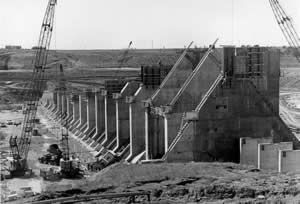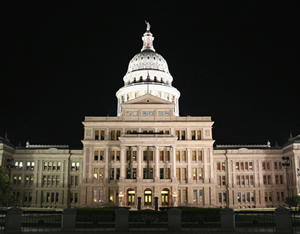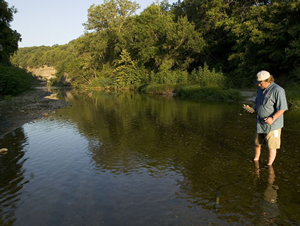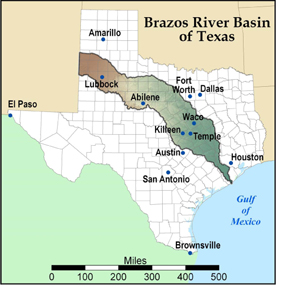What does the Brazos River Authority do?
The mission of the Brazos River Authority (BRA) is to develop, manage, and protect the water resources of the Brazos River Basin to meet the needs of
Texas. The BRA was created by the Texas Legislature in 1929 and was the first state agency in the United States created specifically for the purpose of developing and
managing the water resources of an entire river basin.

In addition to building dams and maintaining lake parks, the BRA provides water to municipalities, industry, agriculture,
and mining within the Brazos basin.
The water stored in the three BRA reservoirs and eight US Army Corps of Engineers lakes within the system is permitted for use by the state’s water
oversight agency, the Texas Commission on Environmental Quality (TCEQ). The TCEQ manages the state’s surface water assets and determines the amount of water made available
through the issuance of water rights permits. The BRA also works with three Texas Regional Water Planning groups to determine the means to provide for the future of water
supply within the state.
Besides water supply, the BRA works to ensure the quality of the water within the basin by providing services such as potable water treatment, wastewater
treatment and continuous monitoring for specific contaminates through the Texas Clean Rivers Program.
Although the BRA is a political subdivision of the State of Texas, it does not levy or collect taxes and does not receive subsidies from the state or the
counties it serves. Except for occasional governmental grants to aid in the cost of specific projects, the BRA is funded entirely through the management of water and
wastewater services and the sale of water supply.
To whom is the Brazos River Authority accountable?
The BRA has several layers of accountability. First, direct oversight of the BRA is vested in the Board of Directors, which is the policy making arm of
the organization. These individuals are appointed by the governor of Texas with the advice and consent of the state senate. The governor’s office also maintains oversight
of the BRA as it is the head of the executive branch of state government.
The BRA is also accountable to the legislature. The organization’s enabling statutes can be found under Chapter 8502 of the Special Districts Local Laws
Code. These enabling statutes provide and enumerate each and every power the BRA has under state law. As an entity created by statute, the BRA is directly
accountable to the state legislators since they have the ability to change the powers and duties of the BRA as they see fit via legislation.

The BRA is accountable to the cities, businesses, and individuals to whom we provide water - since their payments for water fund the Brazos River
Authority’s operations. These entities and individuals have the ability to challenge the BRA’s
ratemaking with the TCEQ if they feel the water rates are not fair.
The TCEQ also maintains oversight of the BRA. This agency is responsible for granting water right permits which in turn allow the BRA to provide water
to the basin. They require annual reports detailing water diversions and usage. TCEQ also grants the BRA permits to operate water and wastewater plants and maintains
oversight of operations of these facilities.
With regard to transparency, the BRA undergoes annual external financial audits which are required to be submitted to the TCEQ, the State Auditor’s Office,
State Comptroller, and the Texas Water Development Board. Additionally, the BRA is subject to audit by the State Auditor if approved by the Legislative Audit Committee.
The BRA also employs an internal auditor that reports to the Board of Directors. The internal auditor performs numerous management audits throughout
the course of the year and reports the results to the BRA Board of Directors.
As for public access, the BRA is a public entity; therefore the Board of Directors meetings are open to the public per the Texas Open Meetings Act. The
Board meets quarterly in January, April, July, and October. Agendas are posted in advance of the meetings on the Authority’s website
here. The public is welcome
to attend these meetings and may address the Board. The BRA is also subject to the Open Records Act, so records may be requested by a member of the public and made
available in accordance with state law.
Financial reports and budgets are available here. Hard copies of these reports are also available upon request.
How do you measure your success?
The BRA measures success by ensuring all water supply commitments are met and by working to create new water sources so that future water demands do not
outpace supply. Additionally, the BRA strives to protect the sound environmental quality of the water in the Brazos basin.
Why are you selling a precious commodity like water?
The basic answer is that the Brazos River Authority provides water to the basin because it is what the organization was created to do. The mission of the
BRA is to develop, manage, and protect the water resources of the Brazos River basin to meet the needs of Texas.

The BRA provides water for such beneficial uses as municipal use, agriculture, irrigation, electric generation, mining and industry, to name a few.
Every person living in the basin directly or indirectly receives a benefit in their everyday lives from the water provided for these purposes.
All surface water in Texas is owned by the state. The BRA is granted the responsibility to provide water to meet the needs of the basin. The state grants
the BRA water to manage in accordance with TCEQ rules and regulations and state law. TCEQ is the entity tasked with regulating water rights in the State of Texas. In
utilizing water, the BRA must obtain a permit to exercise this ability and must abide by the requirements of those permits.
The BRA CAN NOT sell water in excess of the amount of the permits issued by the state. The TCEQ applies consistent standards to all surface water supplies
to determine how much water can be reliably used. The TCEQ standards take into account the amount of runoff, river flow, evaporation, other water users, lake volume, and
historic droughts to set the amount of water allowed to be used in the permits. The BRA’s permits and contracts are all within those standards.
Why do you have 21 board members?
The BRA has a basin that encompasses 42,000 square miles and includes all or part of 70 counties - roughly the size of Tennessee for comparison. The Board
was set up in order to ensure a proper amount of representation from the various areas of the basin. Because the Brazos River basin is so large, the Board is sized at 21 to
reflect proper representation of the full basin.
It seems the BRA just wants more money and continues to sell water for this purpose. Why not cut expenses if you need money?
The BRA does not sell water simply to make money. No person, staff or Board member, profits from BRA sales of water. There is no commission to staff members for
selling water nor are there dividends paid to members of the Board.
The BRA is a self-sustaining entity. Other than a select few state and federal grants, the BRA’s income stream is generated through sales of water and
the delivery of services. Staff members are paid a salary or an hourly wage and Board members serve as volunteers appointed by the governor with only travel expenses being
reimbursed to them.
The BRA receives no taxes or other funding from the state or any other government. Operations are funded by customers who pay the BRA to run the water supply
system, the water and wastewater treatment systems and the environmental monitoring programs throughout the basin. All of these operations are performed in service to these
customers who make up and fund the BRA System.

The costs of funding these operations rarely, if ever, decreases. Therefore, as the cost to provide these services goes up, so do expenses. If the BRA
were to choose to cut expenses, it would be detrimental to customers who depend on them to provide water and other essential services.
The budget is set up along two basic lines of business: water supply system operations and cost reimbursable operations. The water supply system side is
made up of reservoirs, BRA-owned treatment facilities, BRA-owned pipeline systems and contracted water in Corps of Engineer reservoirs. The BRA Water Supply System customers
contract for delivery of water contained within the System for their purposes. In some instances, Lake Granbury as an example, those customers actually paid for the initial
construction of the reservoir from which they derive their supply.
Every year, the BRA determines its system rate or the cost for one acre-foot of water, by determining the amount of funding necessary to operate the water
supply system. The system rate is adopted each July by the Board of Directors for the following fiscal year. At this point, the BRA’s per acre cost of water is one of the
least expensive in the state.
Most importantly, BRA funding also goes toward creating new water supplies in the Brazos River basin. The BRA participates in three regional water planning
groups (Region O, Region G, and Region H) as part of the overall state water planning process.
The State Water Plan estimates that the overall cost of water infrastructure needs within the Brazos basin will total $3 billion over the next 50 years.
As a regional water supply entity, it is the BRA’s responsibility to help fund water projects to meet the demands of an ever increasing population. The Brazos River
Authority budget includes funding for not only current operations, but also for activities and projects necessary to meet the needs of the future.
For additional information about the Brazos River Authority, click
here.